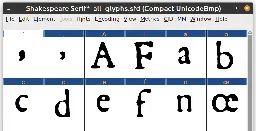Shakespeare Serif - an experimental font based on the First Folio
Shakespeare Serif - an experimental font based on the First Folio

Disclaimer! Work In Progress! See source code. I recently read this wonderful blog post about using 17th Century Dutch fonts on the web. And, because I'm an idiot, I decided to try and build something similar using Shakespeare's first folio as a template. Now, before setting off on a journey, it is ...

I've built a new font! Thoughts and feedback on my approach very welcome.
